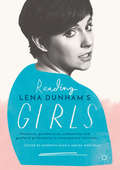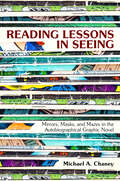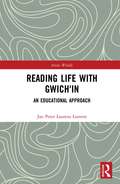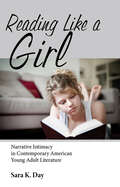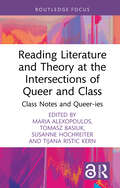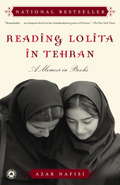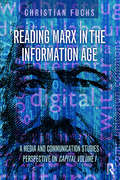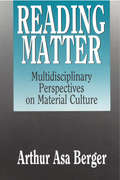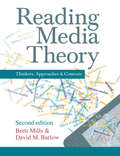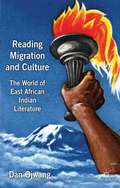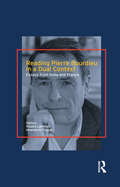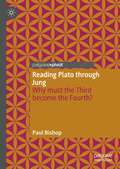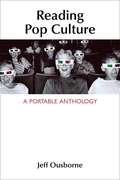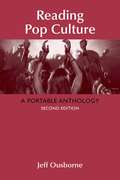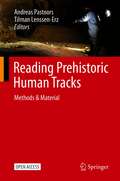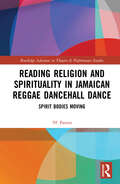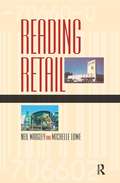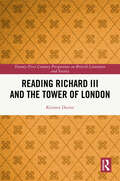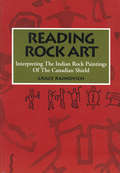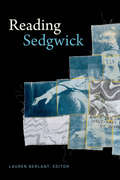- Table View
- List View
Reading Lena Dunham’s Girls
by Imelda Whelehan Meredith NashIn this book, leading and emerging scholars consider the mixed critical responses to Lena Dunham's TV series Girls and reflect on its significance to contemporary debates about postfeminist popular cultures in a post-recession context. The series features both familiar and innovative depictions of young women and men in contemporary America that invite comparisons with Sex and the City. It aims for a refreshed, authentic expression of postfeminist femininity that eschews the glamour and aspirational fantasies spawned by its predecessor. This volume reviews the contemporary scholarship on Girls, from its representation of post-millennial gender politics to depictions of the messiness and imperfections of sex, embodiment, and social interactions. Topics covered include Dunham's privileged role as author/auteur/actor, sexuality, body consciousness, millennial gender identities, the politics of representation, neoliberalism, and post-recession society. This book provides diverse and provocative critical responses to the show and to wider social and media contexts, and contributes to a new generation of feminist scholarship with a powerful concluding reflection from Rosalind Gill. It will appeal to those interested in feminist theory, identity politics, popular culture, and media.
Reading Lessons in Seeing: Mirrors, Masks, and Mazes in the Autobiographical Graphic Novel
by Michael A. ChaneyLiterary scholar Michael A. Chaney examines graphic novels to illustrate that in form and function they inform readers on how they ought to be read. His arguments result in an innovative analysis of the various knowledges that comics produce and the methods artists and writers employ to convey them. Theoretically eclectic, this study attends to the lessons taught by both the form and content of today's most celebrated graphic novels.Chaney analyzes the embedded lessons in comics and graphic novels through the form's central tropes: the iconic child storyteller and the inherent childishness of comics in American culture; the use of mirrors and masks as ciphers of the unconscious; embedded puzzles and games in otherwise story-driven comic narratives; and the form's self-reflexive propensity for showing its work. Comics reveal the labor that goes into producing them, embedding lessons on how to read the "work" as a whole.Throughout, Chaney draws from a range of theoretical insights from psychoanalysis and semiotics to theories of reception and production from film studies, art history, and media studies. Some of the major texts examined include Marjane Satrapi's Persepolis; Chris Ware's Jimmy Corrigan: The Smartest Kid on Earth; Joe Sacco's Palestine; David B.'s Epileptic; Kyle Baker's Nat Turner; and many more. As Chaney's examples show, graphic novels teach us even as they create meaning in their infinite relay between words and pictures.
Reading Life with Gwich'in: An Educational Approach (Arctic Worlds)
by Jan Peter LooversThis book is based upon more than two years of ethnographic fieldwork and personal experiences with the Teetł’it Gwich’in community in northern Canada. The author provides insight into Gwich’in understandings of life as well as into historical and political processes that have taken place in the North. He outlines the development of an educational approach towards conducting ethnography and writing anthropological literature, starting with the premise ‘you have to live it’. The book focuses on ways of knowing and collaboration through learning and being taught by interlocutors. Building on the work of Tim Ingold, Loovers investigates the notion of reading life - land, water and weather as well as texts – and analyses the reading of texts as acts of conversations or correspondences.
Reading Like a Girl: Narrative Intimacy in Contemporary American Young Adult Literature (Children's Literature Association Series)
by Sara K. DayBy examining the novels of critically and commercially successful authors such as Sarah Dessen (Someone Like You), Stephenie Meyer (the Twilight series), and Laurie Halse Anderson (Speak), Reading Like a Girl: Narrative Intimacy in Contemporary American Young Adult Literature explores the use of narrative intimacy as a means of reflecting and reinforcing larger, often contradictory, cultural expectations regarding adolescent women, interpersonal relationships, and intimacy. Reading Like a Girl explains the construction of narrator-reader relationships in recent American novels written about adolescent women and marketed to adolescent women. Sara K. Day explains, though, that such levels of imagined friendship lead to contradictory cultural expectations for the young women so deeply obsessed with reading these novels. Day coins the term “narrative intimacy” to refer to the implicit relationship between narrator and reader that depends on an imaginary disclosure and trust between the story's narrator and the reader. Through critical examination, the inherent contradictions between this enclosed, imagined relationship and the real expectations for adolescent women's relations prove to be problematic. In many novels for young women, adolescent female narrators construct conceptions of the adolescent woman reader, constructions that allow the narrator to understand the reader as a confidant, a safe and appropriate location for disclosure. At the same time, such novels offer frequent warnings against the sort of unfettered confession the narrators perform. Friendships are marked as potential sites of betrayal and rejection. Romantic relationships are presented as inherently threatening to physical and emotional health. And so, the narrator turns to the reader for an ally who cannot judge. The reader, in turn, may come to depend upon narrative intimacy in order to vicariously explore her own understanding of human expression and bonds.
Reading Literature and Theory at the Intersections of Queer and Class: Class Notes and Queer-ies (Focus on Global Gender and Sexuality)
by Tomasz Basiuk Maria Alexopoulos Susanne Hochreiter Tijana Ristic KernReading Literature and Theory at the Intersections of Queer and Class focuses on the crossover of queer and class, examining a range of texts across languages and genres and spanning nearly a century.This collection of chapters considers the intersection of queer and class in relation to literary aesthetics, a locus in which the interaction between sexuality and class is rendered with lucidity. Each chapter puts forward class and its manifestations as central to queer analysis of literary and cultural texts in historical and contemporary contexts. The readings adopt Kimberlé Crenshaw’s intersectional paradigm by pointing to its activist as well as literary precedents and elaborations.These chapters emerged from a long-standing collaboration among three Central European universities whose faculty and graduate students established a joint queer literature and theory research seminar. They are supplemented by a roundtable discussion in which the contributing authors and their colleagues discuss how the concepts of queer and class in theory and (academic) practice have informed their current and previous work.Reading Literature and Theory at the Intersections of Queer and Class is intended for scholars in gender and queer studies.
Reading Lolita in Tehran
by Azar NafisiWe all have dreams--things we fantasize about doing and generally never get around to. This is the story of Azar Nafisi's dream and of the nightmare that made it come true.For two years before she left Iran in 1997, Nafisi gathered seven young women at her house every Thursday morning to read and discuss forbidden works of Western literature. They were all former students whom she had taught at university. Some came from conservative and religious families, others were progressive and secular; several had spent time in jail. They were shy and uncomfortable at first, unaccustomed to being asked to speak their minds, but soon they began to open up and to speak more freely, not only about the novels they were reading but also about themselves, their dreams and disappointments. Their stories intertwined with those they were reading--Pride and Prejudice, Washington Square, Daisy Miller and Lolita--their Lolita, as they imagined her in Tehran.Nafisi's account flashes back to the early days of the revolution, when she first started teaching at the University of Tehran amid the swirl of protests and demonstrations. In those frenetic days, the students took control of the university, expelled faculty members and purged the curriculum. When a radical Islamist in Nafisi's class questioned her decision to teach The Great Gatsby, which he saw as an immoral work that preached falsehoods of "the Great Satan," she decided to let him put Gatsby on trial and stood as the sole witness for the defense.Azar Nafisi's luminous tale offers a fascinating portrait of the Iran-Iraq war viewed from Tehran and gives us a rare glimpse, from the inside, of women's lives in revolutionary Iran. It is a work of great passion and poetic beauty, written with a startlingly original voice.From the Hardcover edition.
Reading Lolita in Tehran: A Memoir in Books
by Azar NafisiWe all have dreams--things we fantasize about doing and generally never get around to. This is the story of Azar Nafisi's dream and of the nightmare that made it come true. For two years before she left Iran in 1997, Nafisi gathered seven young women at her house every Thursday morning to read and discuss forbidden works of Western literature.
Reading Malaysian Literature in English: Ethnicity, Gender, Diaspora, and Nationalism (Asia in Transition #16)
by Mohammad A. QuayumThis book brings together fourteen articles by prominent critics of Malaysian Anglophone literature from five different countries: Australia, Italy, Malaysia, Singapore, and the US. It investigates the thematic and stylistic trends in the literary products of selected writers of the tradition in the genres of drama, fiction, and poetry, from its beginnings to the present, focusing mainly on the postcolonial themes of ethnicity, gender, diaspora, and nationalism, which are central to the creativity and imagination of these writers. The book explores the works of not just the established writers of the tradition but also those who have received little critical attention to date but who are equally gifted, such as Adibah Amin, Edward Dorall, Rehaman Rashid, and Huzir Suleiman. The chapters collectively address the challenges and achievements of writers in the English language in a country where English is widely used in daily life and yet marginalised in the creative domain to elevate the status of writings in the national language, i.e., Bahasa Malaysia. The book will demonstrate that in spite of such recurrent neglect of the medium, Malaysia has produced a number of outstanding writers in the language, who are comparable in creativity and craftsmanship to writers of other Anglophone traditions. The book will be of interest to readers and researchers of Malaysian literature, postcolonial literatures, minority literatures, gender studies, and Southeast Asian studies.
Reading Marx in the Information Age: A Media and Communication Studies Perspective on Capital Volume 1
by Christian FuchsRenowned Marxist scholar and critical media theorist Christian Fuchs provides a thorough, chapter-by-chapter introduction to Capital Volume 1 that assists readers in making sense of Karl Marx’s most important and groundbreaking work in the information age, exploring Marx’s key concepts through the lens of media and communication studies via contemporary phenomena like the Internet, digital labour, social media, the media industries, and digital class struggles. Through a range of international, current-day examples, Fuchs emphasises the continued importance of Marx and his work in a time when transnational media companies like Amazon, Google, and Facebook play an increasingly important role in global capitalism. Discussion questions and exercises at the end of each chapter help readers to further apply Marx’s work to a modern-day context.
Reading Matter: Multidisciplinary Perspectives on Material Culture
by Arthur Asa BergerTo be civilized involves, among other things, making, using, and buying objects. Although speculation on the significance of objects often tends to be casual, there are professionals--anthropologists, historians, semioticians, Marxists, sociologists, and psychologists--who analyze material culture in a systematic way and attempt to elicit from it reliable information about people, societies, and cultures. One reason that analyzing objects has been problematical for scholars is the lack of a sound methodology governing multidisciplinary research. Reading Matter addresses this problem by defining a comprehensive set of methodological approaches that can be used to analyze and interpret material culture and relate it to personality and society.Berger offers discussions of the main concepts found in semiotic, historical, anthropological, psychoanalytic, Marxist, and sociological analysis. He provides practical descriptions of the working methods of each discipline and demarcates their special areas of investigation. Berger's lively discussions include a wealth of illustrative examples that help to clarify the complex and often difficult theories that underlie interpretations of material culture. In the second part of his analysis, Berger uses these disciplines to investigate one subject--fashion and an important aspect of fashion, blue jeans, and what the author calls the denimization phenomenon. Here he shows how different methods of reading material culture end up with different perspectives on things--even when they are dealing with the same topic.The author's focus is on the material culture of post-literate societies and cultures, both contemporary and historical. This comparative approach enables the reader to trace the evolution of objects from past to present or to see how American artifacts spread to different cultures, acquiring a wholly new meaning in the process. Reading Matter is an important contribution to the study of popula
Reading Media Theory: Thinkers, Approaches and Contexts
by Brett Mills David M. BarlowWhat does the Frankfurt School have to say about the creative industries? Does the spread of Google prove we now live in an information society? How is Madonna an example of postmodernism? How new is new media? Does the power of Facebook mean we're all media makers now? This groundbreaking volume – part reader, part textbook - helps you to engage thoroughly with some of the major voices that have come to define the landscape of theory in media studies, from the public sphere to postmodernism, from mass communication theory to media effects, from production to reception and beyond. But much more than this, by providing assistance and questions directly alongside the readings, it crucially helps you develop the skills necessary to become a critical, informed and analytical reader. Each reading is supported on the facing page by author annotations which provide comments, dissect the arguments, explain key ideas and terminology, make references to other relevant material, and pose questions that emerge from the text. Key features: Opening chapters: ‘What is theory?’ and ‘What is reading?’ bring alive the importance of both as key parts of media scholarship Pre-reading: substantial Introductory sections set each text and its author in context and show the relevance of the reading to contemporary culture Post-reading: Reflection sections summarise each reading’s key points and suggests further areas to explore and think about 4 types of annotations help you engage with the reading – context, content, structure, and writing style …. as well as questions to provoke further thought Split into 4 sections – Reading theory, Key thinkers and schools, Approaches and Media Theory in context New to the second edition: New chapters on New Media, and Audiences as Producers Reading Media Theory will assist you in developing close-reading and analytic skills. It will also increase your ability to outline key theories and debates, assess different case studies critically, link theoretical approaches to a particular historical context, and to structure and present an argument. As such, it will be essential reading for undergraduate and postgraduate students of media studies, cultural studies, communication studies, the sociology of the media, popular culture and other related subjects.
Reading Migration and Culture
by Dan OjwangThis book uses the uniquely positioned culture of East African Asians to reflect upon the most vexing issues in postcolonial literary studies today. By examining the local histories and discourses that underpin East African Asian literature, it opens up and reflects upon issues of alienation, modernity, migration, diaspora, memory and nationalism.
Reading Pierre Bourdieu in a Dual Context: Essays from India and France
by Roland Lardinois1. The Crises of Imperial Societies Christophe Charle 2. Thinking the State with Bourdieu and Foucault U. Kalpagam 3. Bourdieu’s Theory of the Symbolic: Traditions and Innovations Sheena Jain 4. The Field of Indian Knowledge in France in the 1930s Roland Lardinois 5. Literature and Politics During the German Occupation Gisele Sapiro 6. Symbolic Violence and Masculine dominance in the Vichy Regime Francine Muel-Dreyfus 7. Habitus, Performance and Women’s Experience in Everyday Life Meenakshi Thapan 8. Pierre Bourdieu and Anthropology Alban Bensa 9. Documents and Testimony: Violence in the Bombay Riots Deepak Mehta Index
Reading Plato through Jung: Why must the Third become the Fourth?
by Paul BishopThis book examines the Jungian imperative that the Third must become the Fourth through the lens of Carl Jung’s complex reception of Plato. While in psychoanalytic discourse the Third is typically viewed as an agent that brings about healing, the author highlights that, in the case of Jung, an early emphasis on the Third as the “transcendent function” gave way to an increasing insistence on the importance of the Fourth. And yet, he asks, why must “the Third become the Fourth”? Paul Bishop begins with a survey of work on Jung’s relation to Plato, before turning to Jung’s readings of the Timaeus and Black Books, as well as Goethe’s Faust II and Nietzsche’s Zarathustra. He proceeds to unpick Jung’s statements on the Third and the Fourth though a compelling analysis of how Jung draws upon religious and alchemical traditions, Pythagorean numerology, his own dream-like experiences and Plato’s cosmology. This book will appeal to practitioners and to scholars working in the history of ideas, psychoanalysis, philosophy, and psychoanalytic theory.
Reading Pleasures: Everyday Black Living in Early America (New Black Studies Series)
by Tara A. BynumIn the early United States, a Black person committed an act of resistance simply by reading and writing. Yet we overlook that these activities also brought pleasure. Tara A. Bynum tells the compelling stories of four early American writers who expressed feeling good despite living while enslaved or only nominally free. The poet Phillis Wheatley delights in writing letters to a friend. Ministers John Marrant and James Albert Ukawsaw Gronniosaw memorialize their love for God. David Walker’s pamphlets ask Black Americans to claim their victory over slavery. Together, their writings reflect the joyous, if messy, humanity inside each of them. This proof of a thriving interior self in pursuit of good feeling forces us to reckon with the fact that Black lives do matter. A daring assertion of Black people’s humanity, Reading Pleasures reveals how four Black writers experienced positive feelings and analyzes the ways these emotions served creative, political, and racialized ends.
Reading Pop Culture: A Portable Anthology
by Jeffrey OusborneReading Pop Culture: A Portable Anthology is a current, compact, inexpensive collection that taps into students' passionate engagement with popular culture in order to help them to become better writers. Its focus on themes of consumption, advertising, identity, technology, television, movies, and new media prompts composition students to think and write about issues they care about. This volume in the popular Bedford/St. Martin's series of Portable Anthologies and Guides offers a trademark combination of high quality and great value.
Reading Pop Culture: A Portable Anthology (Second Edition)
by Jeff OusborneReading Pop Culture: A Portable Anthology, Second Edition, taps into students' interest in pop culture while addressing their need for instruction in critical analysis. <P><P>It combines currency, quality, brevity, and value in a collection of essays and images for first-year or themed writing courses. It presents a variety of voices in terms of gender, sexuality, race, and culture, as well as in topics and time periods. <P><P>It also features more variety of reading selections, including academic essays from scholars and articles published in popular media outlets from emerging writers.
Reading Prehistoric Human Tracks: Methods & Material
by Andreas Pastoors Tilman Lenssen-ErzThis Open Access book explains that after long periods of prehistoric research in which the importance of the archaeological as well as the natural context of rock art has been constantly underestimated, research has now begun to take this context into focus for documentation, analysis, interpretation and understanding. Human footprints are prominent among the long-time under-researched features of the context in caves with rock art. In order to compensate for this neglect an innovative research program has been established several years ago that focuses on the merging of indigenous knowledge and western archaeological science for the benefit of both sides.The book gathers first the methodological diversity in the analysis of human tracks. Here major representatives of anthropological, statistical and traditional approaches feature the multi-layered methods available for the analysis of human tracks. Second it compiles case studies from around the globe of prehistoric human tracks. For the first time, the most important sites which have been found worldwide are published in a single publication. The third focus of this book is on firsthand experiences of researchers with indigenous tracking experts from around the globe, expounding on how archaeological sciencecan benefit from the ancestral knowledge. This book will be of interest to professional archaeologists, graduate students, ecologists, cultural anthropologists and laypeople, especially those focussing on hunting-gathering and pastoralist communities and who appreciate indigenous knowledge.
Reading Religion and Spirituality in Jamaican Reggae Dancehall Dance: Spirit Bodies Moving (Routledge Advances in Theatre & Performance Studies)
by 'H' PattenThis book explores the genealogy of Jamaican dancehall while questioning whether dancehall has a spiritual underscoring, foregrounding dance, and cultural expression. This study identifies the performance and performative (behavioural actions) that may be considered as representing spiritual ritual practices within the reggae/dancehall dance phenomenon. It does so by juxtaposing reggae/dancehall against Jamaican African/neo-African spiritual practices such as Jonkonnu masquerade, Revivalism and Kumina, alongside Christianity and post-modern holistic spiritual approaches. This book will be of great interest to students and scholars in performance studies, popular culture, music, theology, cultural studies, Jamaican/Caribbean culture, and dance specialists.
Reading Retail: A Geographical Perspective on Retailing and Consumption Spaces (Reading Economic Geography Ser.)
by Neil Wrigley Michelle LoweReading Retail captures contemporary debates on the geography of retailing and consumption spaces. It is constructed around a series of 'readings' from key works, and is designed to encourage readers to develop a sense of engagement with the rapidly evolving debates in this field. More than 60 edited readings are integrated into the text, providing a guided route map through the literature and into the study of the geographies of retailing and consumption. The volume also introduces readers to the exciting and interdisciplinary developments unfolding in the 'new retail geography', drawing on up-to-the-minute research material from areas ranging from anthropology to business studies, and tackling issues as diverse as retail internationalization and e-commerce.Reading Retail is unique in bringing together a huge range of perspectives on retailing and consumption spaces and will provide a key source text for students in this field.
Reading Richard III and the Tower of London (21st Century Perspectives on British Literature and Society)
by Kristen DeiterThis is the first book on Richard III and the Tower of London, shedding new light on the King’s reputation, the Castle’s lore, and early modern literature’s role in building associations between them. It is also one of the first books to integrate conceptual blending theory and spatial literary studies, empowering scholars and students to analyze literature and locations in new ways. This book fills gaps in the existing knowledge about both Richard III and the Tower of London. Neither literary nor historical scholarship has treated the process through which Richard III and the Tower became associated in the cultural and historical imagination and how such representations have shaped the King’s reputation and the Castle’s lore. This study analyzes this process while offering new understandings of Richard III as a literary character in prose, drama, and poetry and extending knowledge about the Tower as an iconic literary and cultural symbol.
Reading Rock Art: Interpreting the Indian Rock Paintings of the Canadian Shield
by Grace Rajnovich Wayne YerxaMore than 400 rock paintings adorn the Canadian Shield from Quebec, across Ontario and as far west as Saskatchewan. The pictographs are the legacy of the Algonkian-speaking Cree and Ojibway, whose roots may extend to the beginnings of human occupancy in the region almost 10,000 years ago. Archaeologist Grace Rajnovich spent fourteen years of field research uncovering a multitude of clues as to the meanings of the paintings. She has written a text which is unique in its ability to "see" the paintings from a traditional native viewpoint. Skilfully weaving the imagery, metaphors and traditions of the Cree and Ojibway, the author has recaptured the poetry and wisdom of an ancient culture. Chief Willie Wilson of the Rainy River Band considers Grace’s work "innovative and original."
Reading Rodney King/Reading Urban Uprising
by Robert Gooding-WilliamsReading Rodney King/Reading Urban Uprising keeps the public debate alive by exploring the connections between the Rodney King incidents and the ordinary workings of cultural, political, and economic power in contemporary America. Its recurrent theme is the continuing, complicated significance of race in American society. Contributors: Houston A. Baker, Jr.; Judith Butler; Sumi K. Cho; Kimberle Crenshaw; Mike Davis; Thomas L. Dumm; Walter C. Farrell, Jr.; Henry Louis Gates, Jr.; Ruth Wilson Gilmore; Robert Gooding-Williams; James H. Johnson, Jr.; Elaine H. Kim; Melvin L. Oliver; Michael Omi; Gary Peller; Cedric J. Robinson; Jerry Watts; Cornel West; Patricia Williams; Rhonda M. Williams; Howard Winant.
Reading Romans with Eastern Eyes: Honor and Shame in Paul's Message and Mission
by Jackson W.What does it mean to “read Romans with Eastern eyes”? Combining research from Asian scholars with his many years of experience living and working in East Asia, Jackson directs our attention to Paul's letter to the Romans. He argues that some traditional East Asian cultural values are closer to those of the first-century biblical world than common Western cultural values. In addition, he adds his voice to the scholarship engaging the values of honor and shame in particular and their influence on biblical interpretation. As readers, we bring our own cultural fluencies and values to the text. Our biases and background influence what we observe—and what we overlook. This book helps us consider ways we sometimes miss valuable insights because of widespread cultural blind spots. In Reading Romans with Eastern Eyes, Jackson demonstrates how paying attention to East Asian culture provides a helpful lens for interpreting Paul's most complex letter. When read this way, we see how honor and shame shape so much of Paul's message and mission.
Reading Sedgwick (Theory Q)
by Lauren BerlantOver the course of her long career, Eve Kosofsky Sedgwick became one of the most important voices in queer theory, and her calls for reparative criticism and reading practices grounded in affect and performance have transformed understandings of affect, intimacy, politics, and identity. With marked tenderness, the contributors to Reading Sedgwick reflect on Sedgwick's many critical inventions, from her elucidation of poetry's close relation to criticism and development of new versions of queer performativity to highlighting the power of writing to engender new forms of life. As the essays in Reading Sedgwick demonstrate, Sedgwick's work is not only an ongoing vital force in queer theory and affect theory; it can help us build a more positive world in the midst of the bleak contemporary moment. Contributors. Lauren Berlant, Kathryn Bond Stockton, Judith Butler, Lee Edelman, Jason Edwards, Ramzi Fawaz, Denis Flannery, Jane Gallop, Jonathan Goldberg, Meridith Kruse, Michael Moon, José Esteban Muñoz, Chris Nealon, Andrew Parker, H. A. Sedgwick, Karin Sellberg, Michael D. Snediker, Melissa Solomon, Robyn Wiegman
